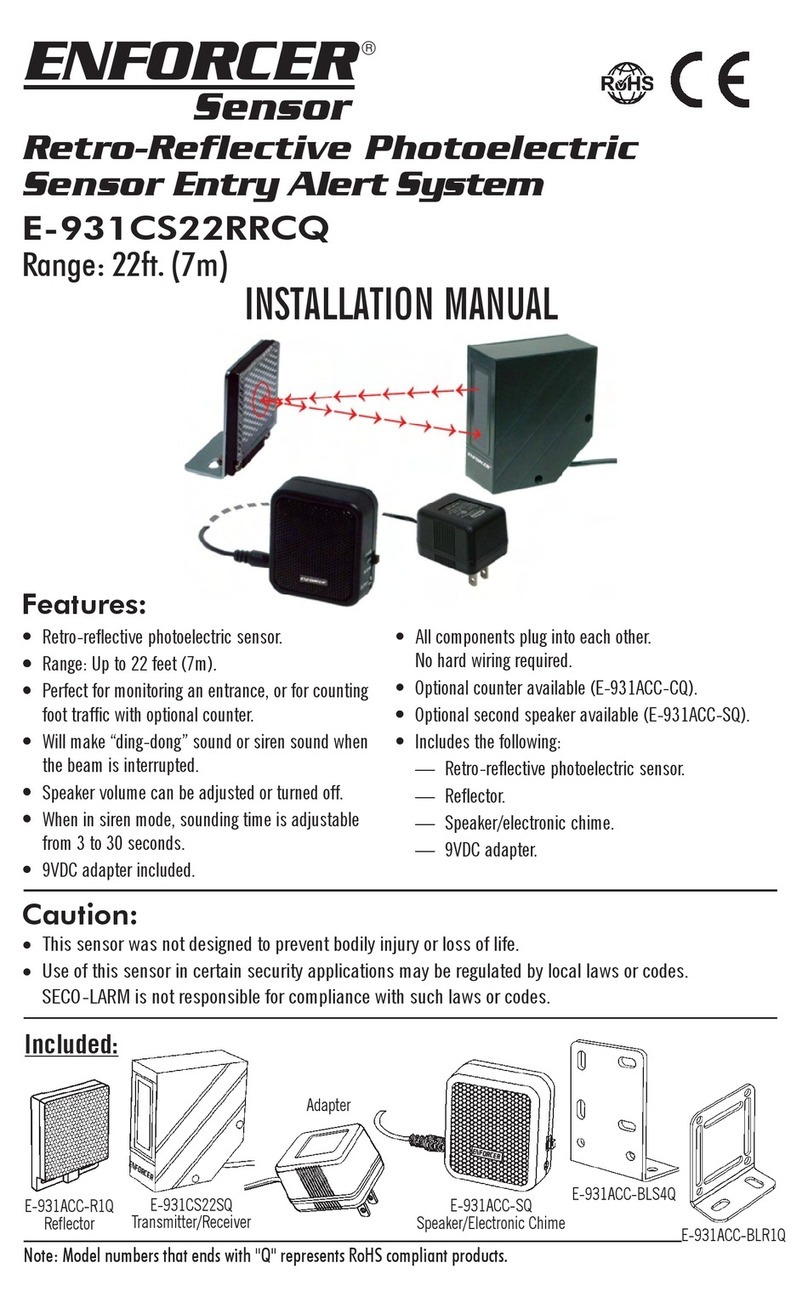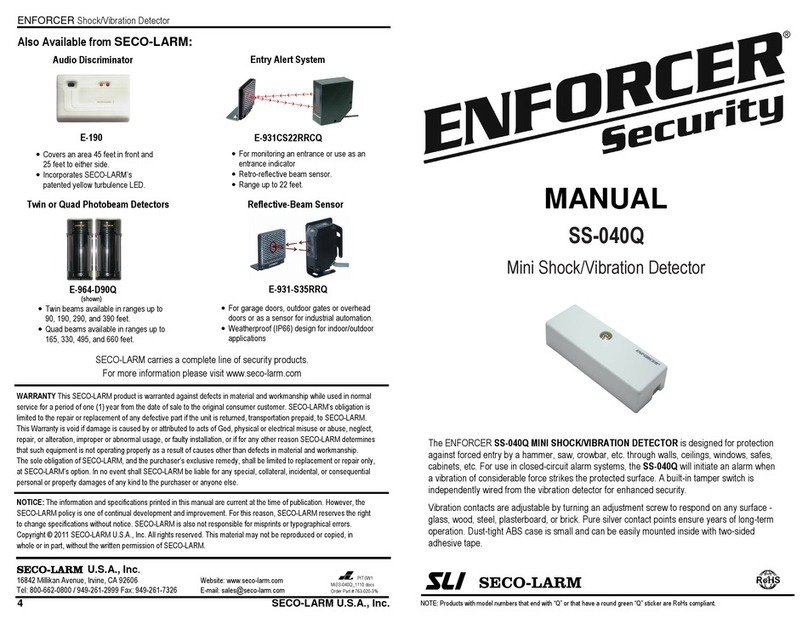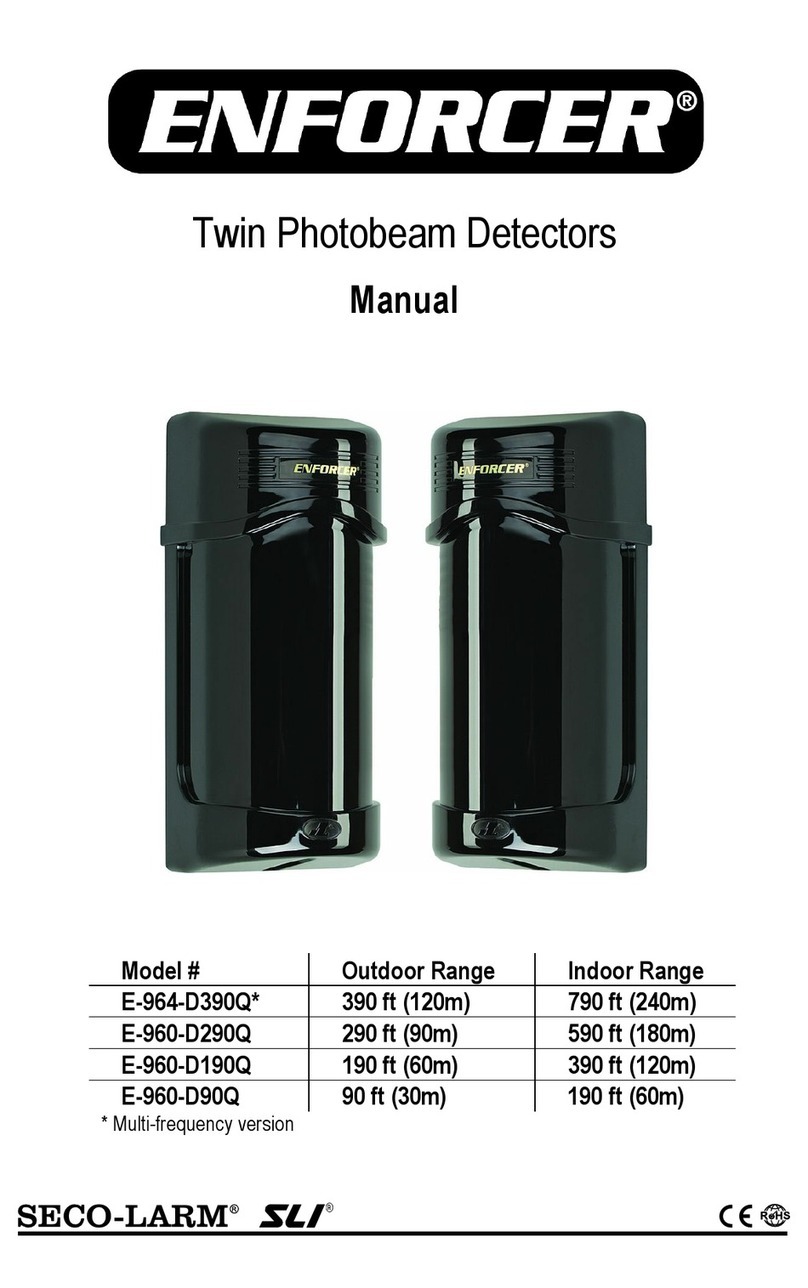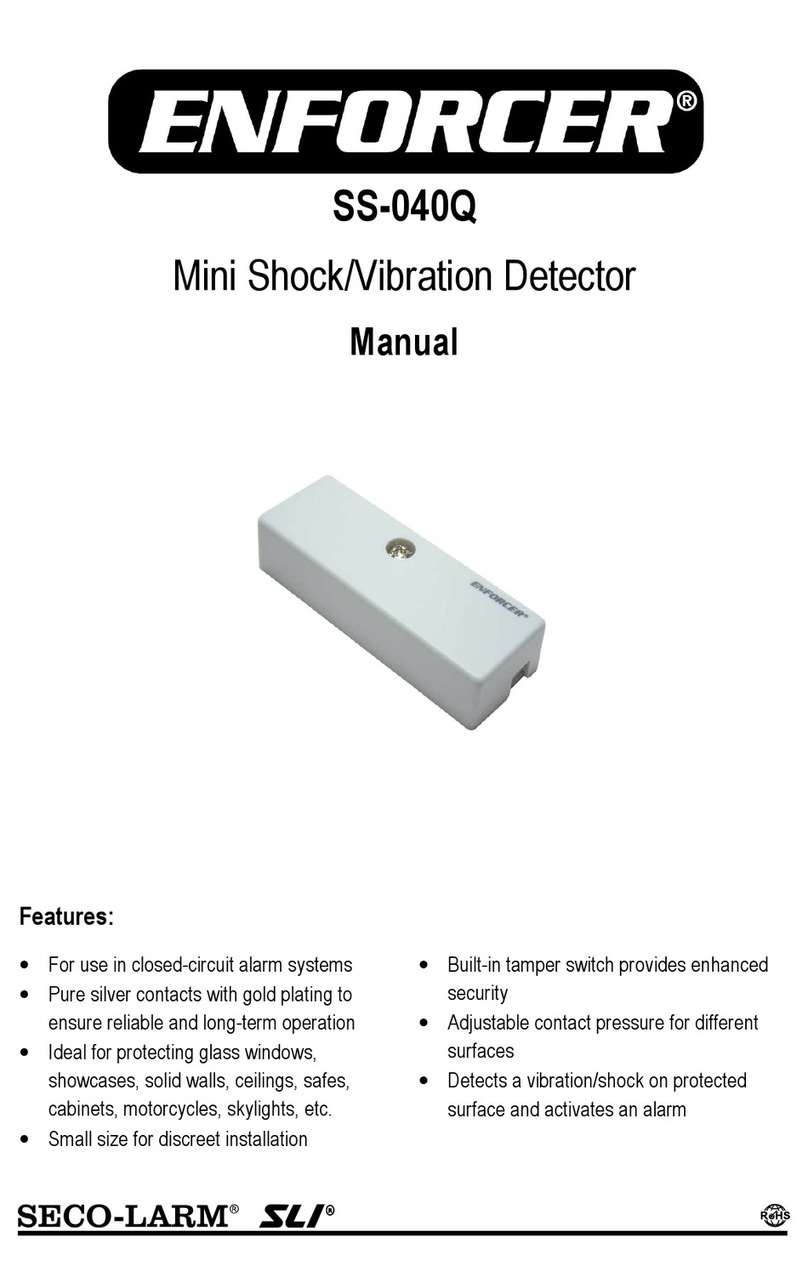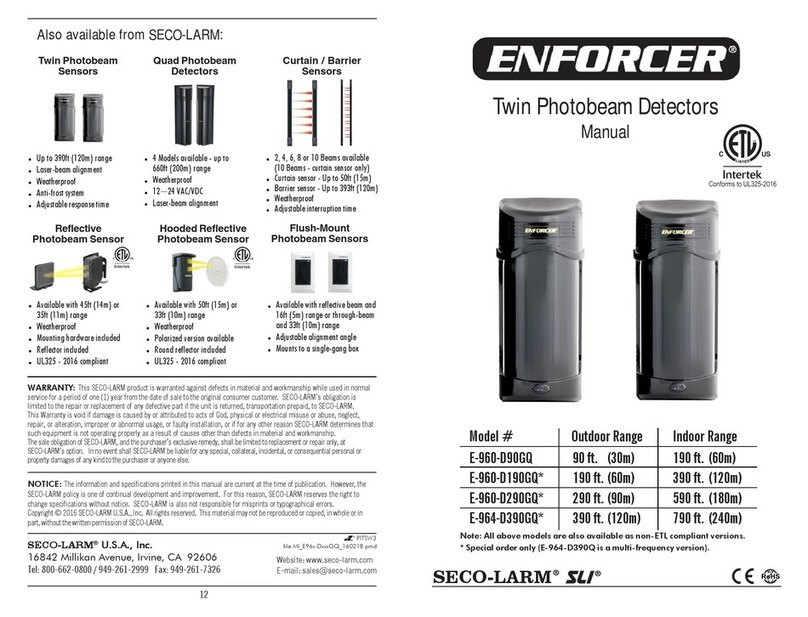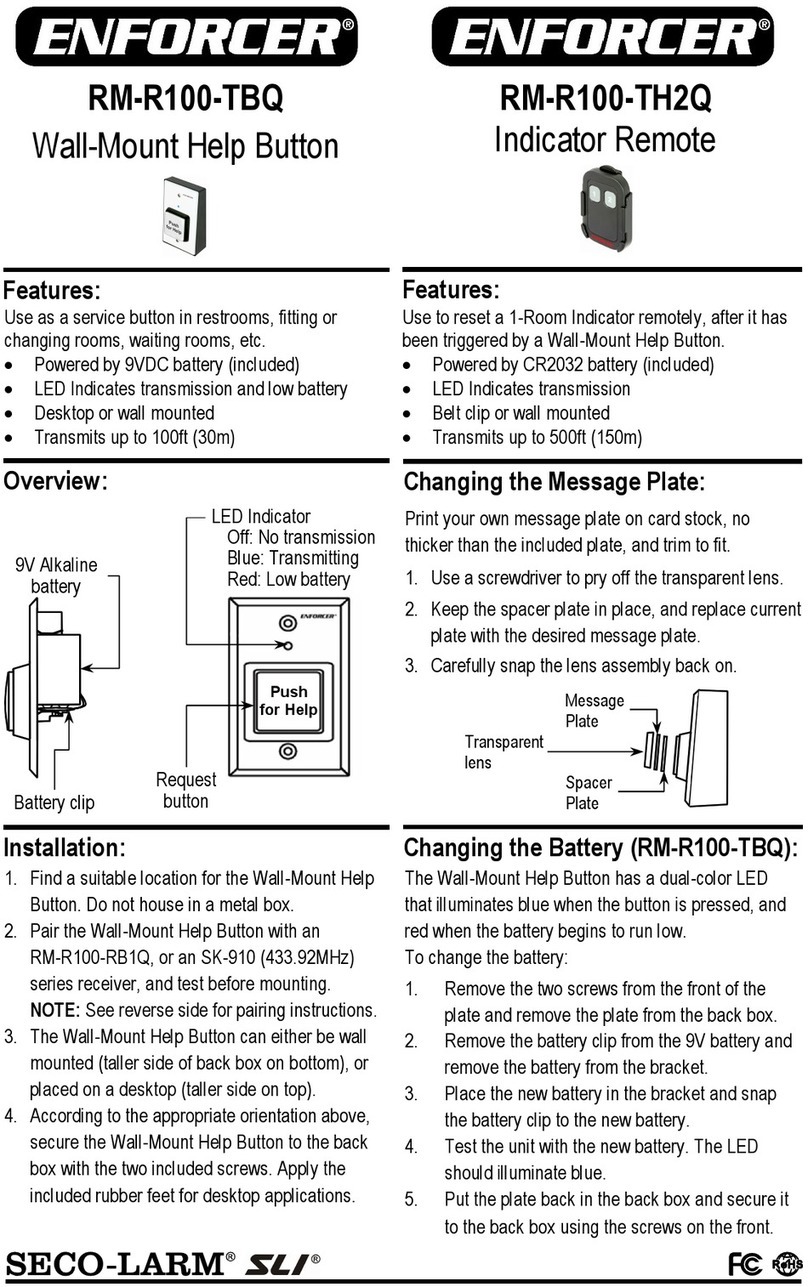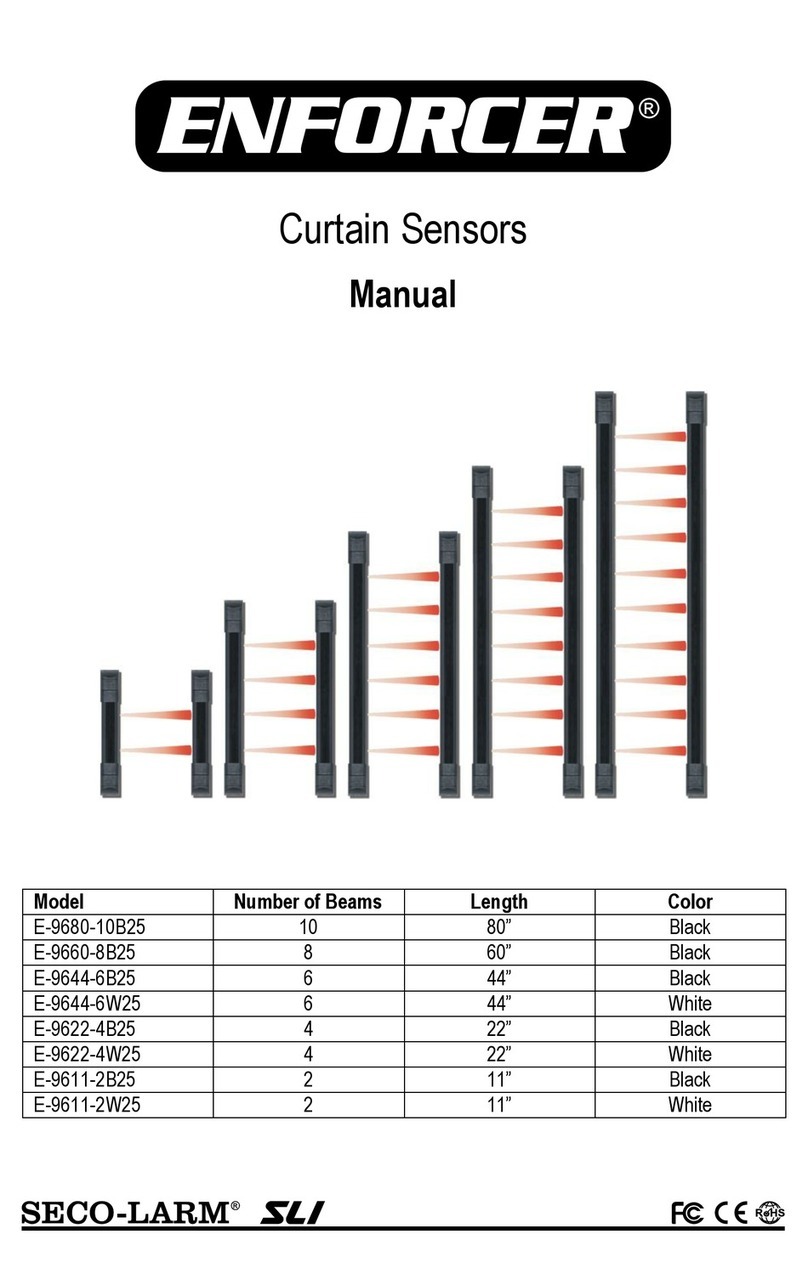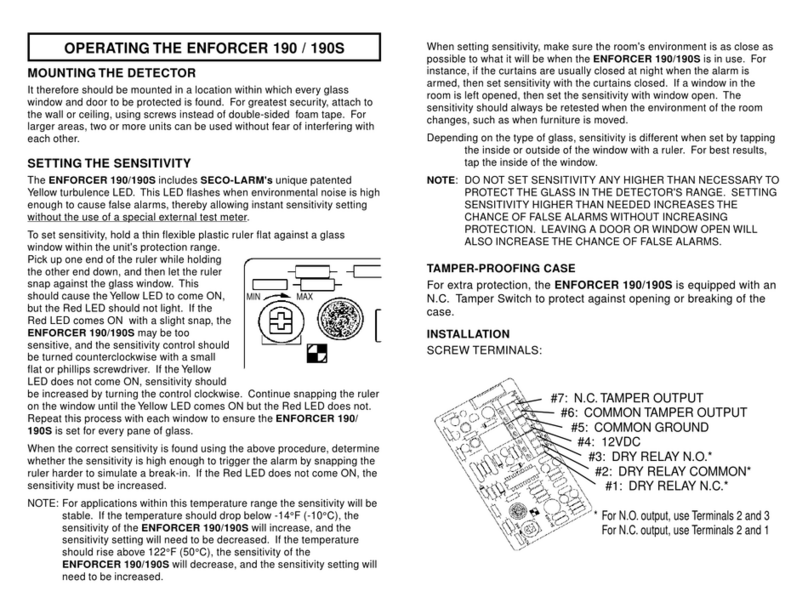
9
4
Running the Cable
Run a cable from the alarm control panel to the photobeam sensor. If burying the cable is required,
make sure to use electrical conduit. Shielded cable is strongly suggested. See Table 1 for maximum
cable length.
Typical Installations
The photoelectric beam lens can be adjusted horizontally ±90°, and vertically ±5° (see fig. 2). This
allows much flexibility in terms of how the transmitter and receiver can be mounted. See fig. 3.
Install at a distance of 32” to 39” (80 to 100 cm) above the ground for most situations. See fig. 3.
Wiring the Transmitter – Wall Mount
1. Remove the cover. Remove the screw under
the lens unit in order to detach the mounting
plate. See fig. 4.
2. If the sensor wiring comes from inside the wall
– Break a hole in the mounting plate’s rubber
grommet, and pull the cable through the
grommet’s hole. Then run the cable through
the hole near the top of the sensor unit so it
comes out the front. Using two of the included
mounting screws, attach the mounting plate to
the wall. Then reattach the sensor unit to the
mounting plate, connect the wires, and snap
on the cover. See fig. 5.
3. If the sensor wiring is run along the surface of
the wall – There are two plastic knockouts on
the back of the sensor unit, one on top and one
on bottom. Break out the appropriate knockout,
and pull the wiring through the knockout. Then
run the wiring through the hole near the top of
the sensor unit so it comes out the front. Using
two of the included mounting screws, attach the
mounting plate to the wall. Then reattach the
sensor unit to the mounting plate, connect the
wires, and snap on the cover. See fig. 6.
Table 1: Cable Length
Note (1):
Max. cable length when two or more sets are connected is the value shown in
Table 1 divided by the number of sets.
Note (2):
The power line can be wired to a distance of up to 3,300 ft. (1,000m) with
AWG22 (0.33mm2) telephone wire.
AWG22
0.33mm2
0.0005in2
AWG20
0.52mm2
0.0008in2
AWG18
0.83mm2
0.0013in2
AWG17
1.03mm2
0.0016in2
320m
1,050 ft.
550m
1,800 ft.
800m
2,600 ft.
980m
3,190 ft.
2,800m
18,000 ft.
4,800m
15,750 ft.
7,200m
23,620 ft.
8,800m
28,870 ft.
280m
920 ft.
450m
1,480 ft.
700m
2,300 ft.
850m
2,790 ft.
12V 24V 12V 24V 12V 24V
Wire Size 12V 24V
E-960-D90Q E-960-D190Q E-960-D290Q
Model E-964-D390Q
2,400m
7,870 ft.
4,200m
13,780 ft.
6,200m
20,340 ft.
7,600m
24,930 ft.
110m
390 ft.
170m
560 ft.
250m
820 ft.
310m
1,020 ft.
900m
2,950 ft.
1,400m
4,590 ft.
2,200m
7,220 ft.
2,600m
8,530 ft.
200m
660 ft.
350m
1,150 ft.
500m
1,640 ft.
590m
1,940 ft.
1,600m
5,250 ft.
3,000m
9,840 ft.
4,200m
13,780 ft.
5,200m
17,060 ft.
Horizontal
Adjustment
Fine Tuning the Receiver
1. Once the sensor is mounted and aligned, the sensor
can be fine tuned using the voltage output jack.
a. Set the range of a volt-ohm meter (VOM) to
0~10VDC.
b. Insert the red (+) probe into the (+) terminal
and the black (-) probe into the (-) terminal.
c. Measure the voltage (see table 4).
d. Adjust the horizontal angle by hand until the
VOM indicates the highest voltage.
e. Adjust the vertical angle by turning the vertical
adjustment screw until the VOM indicates the
highest voltage.
NOTE -Do not interrupt the beam while adjusting alignment.
Fig. 10:
Horizontal and Vertical
Sensor Adjustment
Horizontal
Adjustment
Vertical
Adjustment
View
Finders
Adjusting the Alignment
The transmitter and receiver sensor units can be adjusted ±5º
vertically and ±90º horizontally once the unit is mounted and
power is connected (see fig. 2 on page 3).
There are two ways to adjust alignment:
1. Laser adjustment (see fig. 1 on page 3):
a. Remove the transmitter cover, then turn the laser on with
the ON/OFF switch (see fig. 1 on page 3). A red dot will
show where the photoelectric beams are aimed.
b. Adjust the transmitter's sensor unit vertically and
horizontally until the red dot is centered on the receiver
and both the receiver’s LEDs turn off. See Table 3. It may
be necessary to adjust the horizontal and vertical angle
of the receiver's sensor unit as well.
c. Repeat steps a and b for the receiver.
d. Turn the lasers off, and then replace the covers.
WARNING: Do not look directly at the lasers.
2. Eyeball adjustment (see fig.10):
a. Remove the transmitter cover, and look into one of
the alignment viewfinders (one of the four holes
located between the two lenses) at a 45° angle.
b. Adjust the horizontal angle of the lens vertically
and horizontally until the receiver is clearly seen
in the viewfinder.
c. Repeat steps a and b for the receiver.
d. Replace the transmitter and receiver covers.
NOTE - If you cannot see the opposite unit in the viewfinder, put a sheet of white paper near the unit to
be seen, move your eyes about 2" (5cm) away from the viewfinder, and try again.
Voltage output Alignment quality
3.0~5.0V
2.0~3.0V
1.2~2.0V
<1.2V
Best
Good
Fair
Re-adjust
Table 4:
Note: 5VDC is maximum
possible reading.
Alarm and signal LEDs Signal strength
Two LEDs OFF
One LED ON
Two LEDs ON
Best
Good
Re-adjust
Table 3:
Receiver LED Indicators
